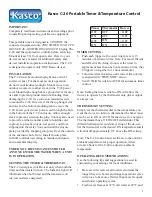
28
6.
TIMER APPLICATION EXAMPLES
This section illustrates two applications for the
BA578E when configured as a Timer.
6.1
Measuring the time that a contact is
closed.
In this example a BA578E is required to display the
time that a process area contact is closed. The
display is required in hours and minutes and is to be
reset to zero by an exterior push button, not by the
instrument front panel push buttons.
The operator
is required to zero the grand total by operating the
)
+
*
buttons simultaneously.
No security
codes are required to protect access to the
configuration menu or to the grand total reset.
Figure 11 shows the BA578E connections.
This
example illustrates how the Timer may be started
and stopped by one input, the second input is not
used in this application.
Fig 11 Starting & stopping timer with one input
The required instrument configurations for this
example are shown below.
Function
Display
Setting
Access code
CodE
0000
Function
FunCtion
ELAP5E
Input A
inPut-A
ContACt
De-bounce Input A
dEbounCE
dEFAuLt
Display 2
di5P-2
oFF
Start stop
5tAr5toP
ControL 4
Units
unit5
12 : 00
Set time
5Et t
9999 : 59 :59
Local total reset
rE5E EnbL
oFF
Local grand total reset
Clr Gtot
on
6.2
Controlling a solenoid valve
This example illustrates how a BA578E Timer can
open a solenoid valve for 5 minutes each time a
start button is operated.
The operator needs to
pause the process without affecting the total time
that the valve is open. At the end of the process the
Timer is required to automatically reset within 10
seconds ready for the next timing cycle to be
started.
For this application the BA578E Timer requires dual
control outputs which are a factory fitted option and
should be specified when the instrument is ordered.
Control output 1 is used to switch the intrinsically
safe solenoid valve, and control output 2 is wired to
the Timer's reset terminals to perform the automatic
resetting at the end of the timing cycle, see Fig 12.
The Timer is configured to perform one timing cycle
cycl cnt
with a restart delay
r5t dela
of 5s and Set
time
5et t
is adjusted to 5 minutes the required time
that that the valve is to be open.
Control outputs are configured so that control output
one is only closed when the timer is in the
Run
state.
Control output 2 is configured to only close when the
Timer is in the
Done
state which occurs after it has
been in the Restart-delay state for 5 seconds. The
sequence of events is shown in Fig 12 and the
Timer's configuration at the end of this section.
This valve opening process is to be linked to other
processes, therefore the status output is required to
indicate when the 5 minute valve open period has
been completed and when the Timer has been reset
and is ready for the next cycle.
When the start button is operated the Timer enters
the
Running
state and control output 1 closes for 5
minutes opening the solenoid valve. At the end of
the 5 minute period control output 1 opens which
closes the solenoid valve and the Timer enters the
Restart-delay
state for 5 seconds followed by the
Done
state. Control output 2 is configured to close
when the Timer is in the
Done
state. Control output
2 is externally connected to the Timer's reset
terminals which causes the Timer to automatically
reset ready to start another cycle when the start
button is operated.
If at any time during the cycle the stop button is
operated the Timer will enter the Pause state which
will stop the process until the start button is operated
when it will resume without shortening the total valve
open time.
















































